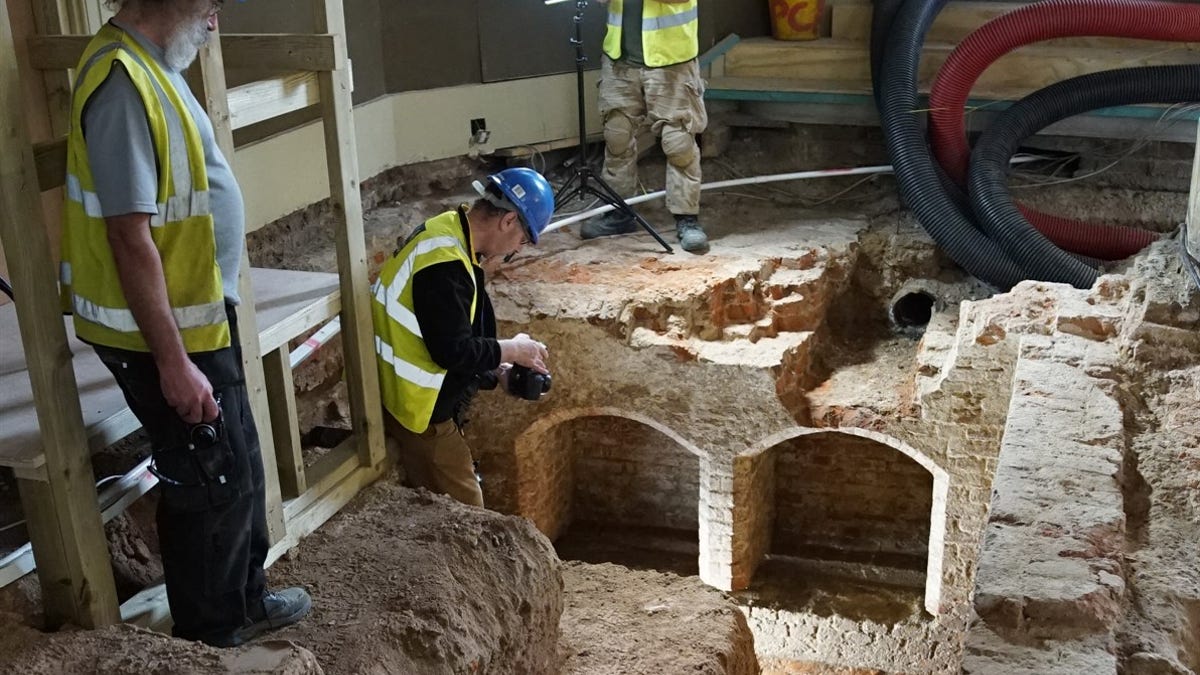
Archaeologists document the Tudor finds beneath the Painted Hall of the Old Royal Naval College shortly after their excavation. (Old Royal Naval College)
Archaeologists in London have uncovered the remains of Greenwich Palace, the birthplace of Henry VIII and Elizabeth I.
The palace, which once stood on the site now occupied by the Old Royal Naval College, has been revealing some of its secrets. Two rooms from the Tudor-era palace were found when the ground beneath the Old Royal Naval College’s Painted Hall was being prepared for a new visitor center.
800-YEAR-OLD COFFIN BREAKS AFTER CHILD PUT IN IT FOR PHOTO OP
William Palin, director of conservation at the Old Royal Naval College told Fox News experts have excavated a tiled floor measuring 16.4 feet by 10 feet, and more than 6 feet beneath that, a brick cellar with round headed niches, an "immaculate" brick floor and the remnants of an arched vault. “This is a highly significant discovery, given the extent of the archaeology and the good condition of the remains," he explained, via email. "As work continues on analysing the remains it is hoped that they will offer rich and valuable information on the working of the palace.”

The palace was built on the south bank of the Thames Humphrey, Duke of Gloucester, in 1426 and rebuilt by Henry VII between 1500 and 1506. It was demolished at the end of the seventeenth century to make way for the Royal Hospital for Seamen, which later became the Royal Naval College. The location, which ceased to be an officers’ training academy in 1997, is now the Old Royal Naval College, an important U.K. heritage site. Paintings show that the palace occupied much of the land where the Old Royal Naval College now stands.
TEENAGER'S DISCOVERY OF ROMAN TREASURE TROVE DELIGHTS EXPERTS
With nothing of the old palace surviving above ground, the underground rooms offer a fascinating glimpse into the life of the Tudor court.
“It is not known where exactly in the palace these rooms were located, but they date to the Henrician period (the time of Henry VIII),” said Palin. “They could be part of the armoury or the remains of one of the several houses built for courtiers on this part of the site.”
RARE ROMAN COIN DISCOVERED ON REMOTE SCOTTISH ISLAND
Archaeologists believe that the niches may be ‘bee boles’ for keeping ‘skeps,’ or hive baskets, during winter periods when bee colonies are hibernating. During the summer months, when the skeps were outside, the niches may have been used to keep food and drink cool.
Experts note that Greenwich Palace was comparable to existing Hampton Court Palace in scale and magnificence. The palace complex comprised state apartments, courtyards, a chapel, gardens and a ‘tiltyard’ for jousting, complete with five-story viewing tower. Henry VIII was born at the palace, as were his daughters Mary and Elizabeth I.
TROVE OF ANCIENT ROMAN LETTERS UNEARTHED NEAR HADRIAN'S WALL
“This is a really remarkable find. The Tudor period is one which grips the public imagination like no other, probably because of the larger-than-life characters like Henry VIII and Elizabeth I, as well as the magnificence of the buildings,” said Duncan Wilson, chief executive of Historic England, in a statement. “To find a trace of Greenwich Palace, arguably the most important of all the Tudor palaces, is hugely exciting.”
Follow James Rogers on Twitter @jamesjrogers
